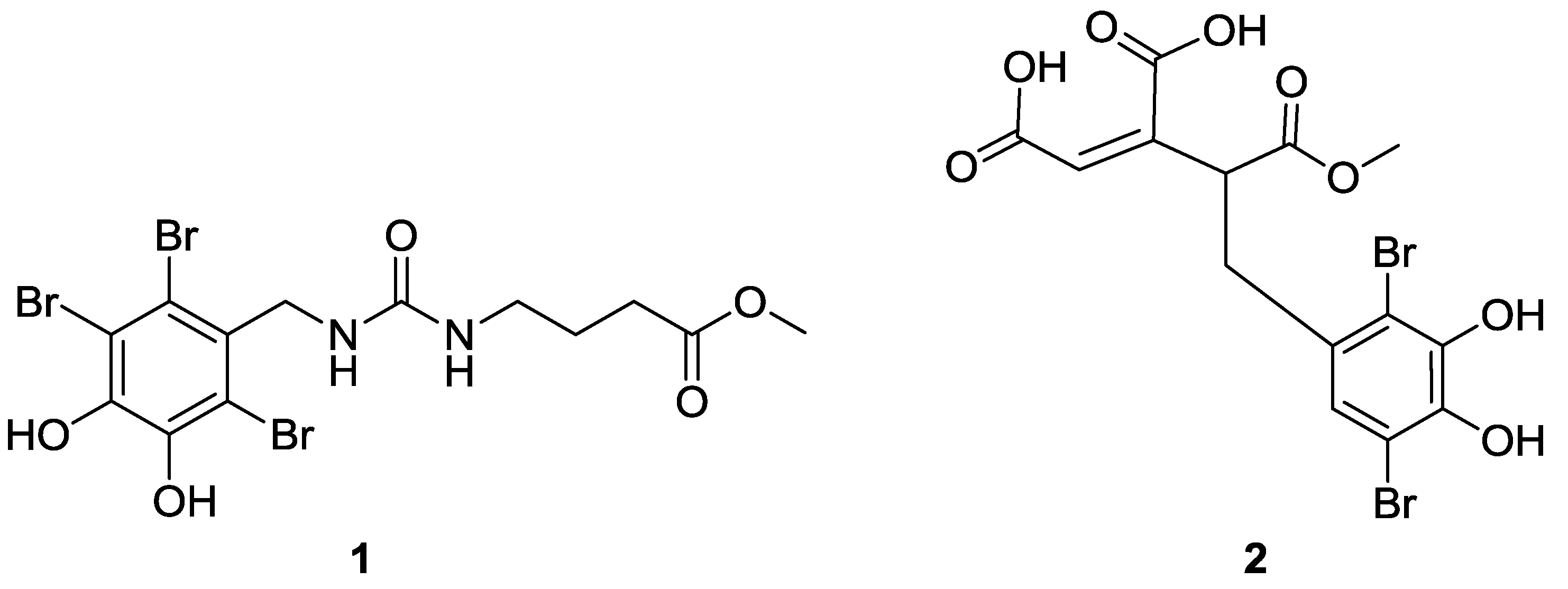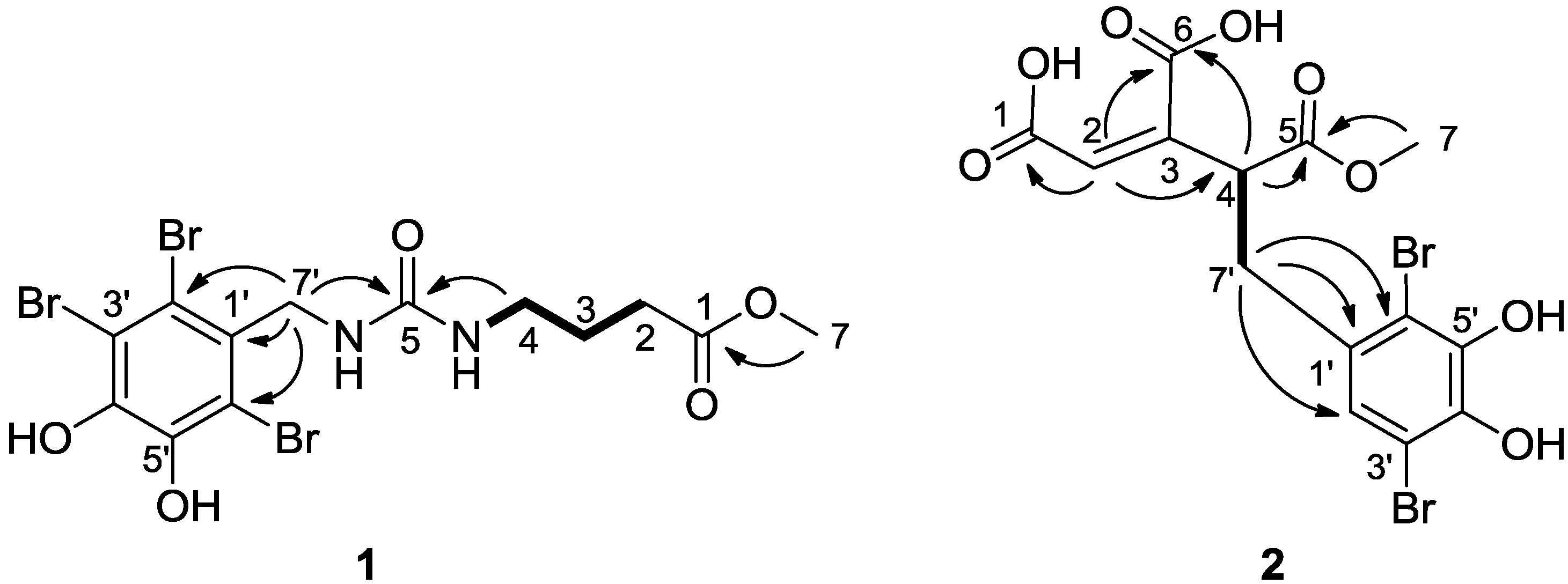Two New Bromophenols with Radical Scavenging Activity from Marine Red Alga Symphyocladia latiuscula
Abstract
:1. Introduction

2. Results and Discussion
| Compound 1 | Compound 2 | |||||
|---|---|---|---|---|---|---|
| pos | C mult | (J in Hz) | HMBC a | C mult | (J in Hz) | HMBC a |
| 1 | 173.2, C | 168.4, C | ||||
| 2 | 30.7, CH2 | 2.28, t (6.6) | 1, 3, 4 | 131.5, CH | 6.76, s | |
| 3 | 25.5, CH2 | 1.60, quint (6.6) | 1, 2, 4 | 144.2, C | ||
| 4 | 38.5, CH2 | 2.99, quart (6.6) | 2, 3, 5 | 44.2, CH2 | 5.06, dd (10.8, 4.2) | 2, 3, 5, 6, 7′ |
| N–H | 5.84, brt (6.6) | |||||
| 5 | 157.4, C | 174.2, C | ||||
| 6 | 169.1, C | |||||
| OMe | 51.2, CH3 | 3.58, s | 1 | 52.7, CH3 | 3.68, s | 5 |
| 1′ | 129.7, C | 132.0, C | ||||
| 2′ | 116.8, C | 126.3, CH | 6.73, s | 3′, 4′, 6′, 7′ | ||
| 3′ | 113.8, C | 109.6, C | ||||
| 4′ | 144.7, C | 143.7, C | ||||
| 5′ | 143.7, C | 145.4, C | ||||
| 6′ | 113.7, C | 113.5, C | ||||
| 7′ | 46.7, CH2 | 4.51, d (4.8) | 1′, 2′, 6′ | 36.9, CH2 | 3.60, dd (13.8, 4.2 ) | 3, 4, 5, 1′, 2′, 6′ |
| 5 | 2.98, dd (13.8, 10.8 ) | 3, 4, 5, 1′, 2′, 6′ | ||||
| N–H′ | 5.85, brt (4.8) | |||||

3. Experimental Section
3.1. General Experimental Procedures
3.2. Algal Material
3.3. Extraction and Isolation
3.4. Scavenging Ability on 1,1-Diphenyl-2-picrylhydrazuyl (DPPH) Radical
4. Conclusions
Acknowledgments
References
- Tseng, C.K. Common Seaweeds of China; Science Press: Beijing, China, 1983; p. 160. [Google Scholar]
- Kurata, K.; Amiya, T. Bis(2,3,6-tribromo-4,5-dihydroxybenzyl) ether from the red alga, Symphyocladia latiuscula. Phytochemistry 1980, 19, 141–142. [Google Scholar]
- Xu, X.L.; Song, F.H.; Fan, X.; Fang, N.Q.; Shi, J.G. A novel bromophenol from marine red alga Symphyocladia latiuscula. Chem. Nat. Compd. 2009, 45, 811–813. [Google Scholar] [CrossRef]
- Xu, X.L.; Piggott, A.M.; Yin, L.Y.; Capon, R.J.; Song, F.H. Symphyocladins A–G: Bromophenol adducts from a Chinese marine red alga, Symphyocladia latiuscula. Tetrahedron Lett. 2012, 53, 2103–2106. [Google Scholar] [CrossRef]
- Xu, X.L.; Yin, L.Y.; Wang, Y.H.; Wang, S.Y.; Song, F.H. A new bromobenzyl methyl sulphoxide from marine red alga Symphyocladia latiuscula. Nat. Prod. Res. 2012. [Google Scholar] [CrossRef]
- Choi, J.S.; Park, H.J.; Jung, H.A.; Chung, H.Y.; Jung, J.H.; Choi, W.C. A cyclohexanonyl bromophenol from the red alga Symphyocladia latiuscula. J. Nat. Prod. 2000, 63, 1705–1706. [Google Scholar] [CrossRef]
- Duan, X.J.; Li, X.M.; Wang, B.G. Chemical constituents of the red alga Symphyocladia latiuscula. J. Nat. Prod. 2007, 70, 1210–1213. [Google Scholar] [CrossRef]
- Wang, W.; Okada, Y.; Shi, H.B.; Wang, Y.Q.; Okuyama, T. Structures and aldose reductase inhibitory effects of bromophenols from the red alga Symphyocladia latiuscula. J. Nat. Prod. 2005, 68, 620–622. [Google Scholar] [CrossRef]
- Park, H.J.; Kurokawa, M.; Shiraki, K.; Nakamura, N.; Choi, J.S.; Hattori, M. Antiviral activity of the marine alga Symphyocladia latiuscula against herpes simplex virus (HSV-1) in vitro and its therapeutic efficacy against HSV-1 infection in mice. Biol. Pharm. Bull. 2005, 28, 2258–2262. [Google Scholar] [CrossRef]
- Lee, J.H.; Park, S.E.; Hossain, M.A.; Kim, M.Y.; Kim, M.; Chung, H.Y.; Choi, J.S.; Yoo, Y. 2,3,6-Tribromo-4,5-dihydroxybenzyl methyl ether induces growth inhibition and apoptosis in MCF-7 human breast cancer cells. Arch. Pharm. Res. 2007, 30, 1132–1137. [Google Scholar] [CrossRef]
- Jin, H.J.; Oh, M.Y.; Jin, D.H.; Hong, Y.K. Identification of a Taq DNA polymerase inhibitor from the red seaweed Symphyocladia latiuscula. J. Eviron. Biol. 2008, 29, 475–478. [Google Scholar]
- Ma, M.; Zhao, J.L.; Wang, S.J.; Li, S.; Yang, Y.C.; Shi, J.G.; Fan, X.; He, L. Bromophenols coupled with methyl γ-ureidobutyrate and bromophenol sulfates from the red alga Rhodomela confervoides. J. Nat. Prod. 2006, 69, 206–210. [Google Scholar] [CrossRef]
- Wiegel, J.; Wu, Q. Microbial reductive dehalogenation of polychlorinated biphenyls. FEMS Microbiol. Ecol. 2000, 32, 1–15. [Google Scholar] [CrossRef]
- Shimada, K.; Fujikawa, K.; Yahara, K.; Nakamura, T. Antioxidative properties of xanthan on the antioxidation of soybean oil in cyclodextrin emulsion. J. Agric. Food Chem. 1992, 40, 945–948. [Google Scholar] [CrossRef]
- Samples Availability: Available from the authors.
© 2013 by the authors; licensee MDPI, Basel, Switzerland. This article is an open access article distributed under the terms and conditions of the Creative Commons Attribution license (http://creativecommons.org/licenses/by/3.0/).
Share and Cite
Xu, X.; Yin, L.; Gao, L.; Gao, J.; Chen, J.; Li, J.; Song, F. Two New Bromophenols with Radical Scavenging Activity from Marine Red Alga Symphyocladia latiuscula. Mar. Drugs 2013, 11, 842-847. https://doi.org/10.3390/md11030842
Xu X, Yin L, Gao L, Gao J, Chen J, Li J, Song F. Two New Bromophenols with Radical Scavenging Activity from Marine Red Alga Symphyocladia latiuscula. Marine Drugs. 2013; 11(3):842-847. https://doi.org/10.3390/md11030842
Chicago/Turabian StyleXu, Xiuli, Liyuan Yin, Lijie Gao, Junhai Gao, Junhui Chen, Jingxi Li, and Fuhang Song. 2013. "Two New Bromophenols with Radical Scavenging Activity from Marine Red Alga Symphyocladia latiuscula" Marine Drugs 11, no. 3: 842-847. https://doi.org/10.3390/md11030842
APA StyleXu, X., Yin, L., Gao, L., Gao, J., Chen, J., Li, J., & Song, F. (2013). Two New Bromophenols with Radical Scavenging Activity from Marine Red Alga Symphyocladia latiuscula. Marine Drugs, 11(3), 842-847. https://doi.org/10.3390/md11030842




